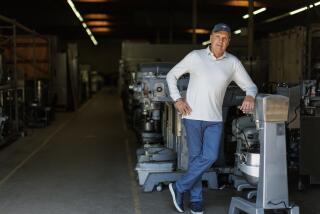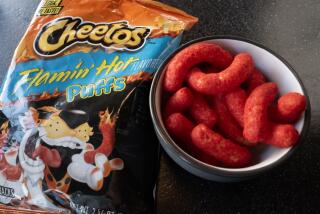SOUTHERN CALIFORNIA ENTERPRISE : Frankly Ambitious : Square H Brands Wants to Make Hoffy a Top Dog
To make hot dogs, many chunks of meat are shoveled into a vat where sharp knives slice and dice and pulverize them into a mush that, after being pushed into casings and smoked at high temperatures, turns into one of America’s food basics.
The people who make the Hoffy brand of hot dogs, made famous on local television in the 1970s and ‘80s by singer Pat Boone, must feel as if they have been through a similar process.
A longtime Southern California company that thrived for years in the competitive meatpacking industry, Hoffman Bros. Packing Co. and its Hoffy line of hot dogs, bacon, ham and sausages fell on hard times in the late 1980s, finally filing for Bankruptcy Court protection in 1993.
Now the company’s assets have been sold to a group of investors with more than 80 years of combined experience in the meatpacking and food-processing industries. Hoffy’s new parent company, Square H Brands Inc., is developing plans to regain the market share the Hoffy brand slowly lost over the years. And Hoffy’s 150 long-suffering employees are hoping to recapture salary and benefits lost during the lean times.
“The whole heart and soul of the business is the Hoffy brand,” said Henry Haskell, president of Square H Brands and one of the company’s owners. “I like to say this brand has been forgotten, not damaged.”
The sign at the entrance of the company’s Vernon-area plant proclaims its “Have a Hoffy” slogan that vanished from local airwaves a decade ago and all but disappeared from grocery store shelves. The brands are still carried sporadically by most grocery chains, but most of Hoffy’s sales are to institutional customers, including schools, restaurants and military installations, Haskell said. Annual revenue exceeds $20 million.
The sign also still carries the name of Hoffman Bros. Packing, a company founded in the 1930s by three siblings.
Hoffman grew steadily for years in the thriving meatpacking industry that grew up around Vernon. Everyone knew the brand names of Oscar Mayer and Farmer John, but dozens of other companies made a good living by trucking live animals into one end of their factories and sending finished products out the other end, or by processing meat that had been slaughtered by other companies.
But in the 1980s, everything changed.
A few big companies in the Midwest began to dominate the industry, and competition increased from chicken and other protein sources. Many local meatpacking companies were sold, went out of business or switched to different kinds of specialty food processing. Madison, Wis.-based Oscar Mayer closed its Vernon plant in 1990, idling more than 500 workers.
Hoffman had problems of its own. In Bankruptcy Court filings, the company detailed a 1985 investment in a Nebraska hog-slaughtering operation that went sour. Hoffman never recovered from the resulting cash crisis.
The employees union tells a different story, tracing the company’s decline to the 1981 death of Hoffman President Robert Levinson, who was married to one of the founder’s daughters. Other family members took over, but none had Levinson’s years of meat industry experience, according to Jim Rodriguez, a director of the United Food & Commercial Workers Local 770, which represents Hoffman employees.
Debts totaled nearly $6 million in April, 1993, when Hoffman filed for protection from its creditors under Chapter 11 of the U.S. Bankruptcy Code. Chapter 11 allows a company to continue operating under existing management while it works out a plan to repay its debts.
For Hoffman, that meant finding a buyer for the company. Among those that came shopping was the group that became Square H Brands, which took possession of the assets of Hoffman in August after paying about $4.5 million.
Besides Haskell, the investors are members of the Hirsch family, which owns Costa Mesa-based Stagg Foods, the West’s largest manufacturer and marketer of canned chili. Family patriarch Clement L. Hirsch is a veteran of the Southern California meat industry, with more than 50 years in the business.
Hirsch founded Kal Kan Foods after enjoying some success selling dog food door-to-door in Southern California in the 1930s. Hirsch made the company grow through business and marketing savvy; he delighted in being photographed at the grocery store noshing on Kal Kan dog food to demonstrate the wholesomeness of the product. In 1968, Hirsch sold Kal Kan Foods to Mars Inc. and, holding onto a small food-processing subsidiary, began building what became Stagg Foods.
The other investors are Hirsch’s younger son, Greg, who now runs Stagg Foods, and his older son, Clement L. (Bo) Hirsch Jr., who owns a company called Palisades Foods, which makes frozen burritos. Haskell’s experience includes 15 years at Mars--several of those at its Kal Kan subsidiary--and three years with Stagg.
“When you listen to all three of them, your head spins,” the eldest Hirsch said of Haskell and his sons. “They’re talking about chili hot dog burritos.”
“I’ve eaten Hoffy hot dogs for 30 years--maybe 40 years. They’re my favorite food, but I’m only 81,” he said.
Union director Rodriguez said the Hoffy workers “suffered greatly” during the bankruptcy and are hopeful about the future.
“The mood of the workers is very positive,” Rodriguez said. “We feel very confident that the leadership of Square H Brands is going to make this a very, very successful company.” The union is negotiating a new collective-bargaining agreement and “we are looking forward to working with management to help Hoffy grow,” he said.
Hoffy processes 200,000 pounds of bacon and 100,000 pounds of hot dogs and other sausages a week, said Steve Reeder, operations manager. Most Hoffy hot dogs are skinless, which means they are smoked in plastic “skins” that are removed before packaging. A small percentage are made with natural casings of sheep intestine, the way Italian and some other types of sausages are made. The company also produces ham and sells a variety of byproducts, such as pig tails and ham hocks.
Hoffy operates its own USDA-approved lab to monitor the chemical composition of its products, necessary to ensure that the hot dogs, for example, never exceed the 30% fat limit set by law. A U.S. Department of Agriculture inspector is at the plant every day.
“Hot dogs have gotten a bum rap,” said Reeder as he watched workers toss beef chunks into a large chopper. “All the stories you hear about the disgusting nature of hot dogs simply are not true.”
One of Hoffy’s most high-profile customers is Pink’s Famous Chili Dogs in Hollywood, which has sold Hoffy hot dogs since Paul Pink started with his first hot dog cart in 1939. Actor Bruce Willis is said to have proposed to Demi Moore over a Pink’s dog, said Gloria Pink, Paul’s daughter-in-law.
“We are delighted that we are going to continue to carry Hoffy dogs,” Pink said. “We owe all of our success to Hoffy. That’s our best seller,” with up to 1,500 Hoffy hot dogs being consumed per day.
Pink’s sells the dogs with natural casings because “people love the way they snap or pop when you bite into them,” Pink said. “Pink’s is a fun place and there’s great people-watching, but it’s really the food that people come back for.”
Haskell said Square H plans to update and re-engineer the Hoffy facility and has the capital to do it. Much of the machinery dates to the 1960s or earlier. The company is also trying to reduce costs in ways that don’t involve layoffs.
The product packaging too is more than a decade old and is being redesigned, Haskell said. The company wants to increase consumer awareness of Hoffy products and get them into more supermarkets.
“This is definitely a turnaround,” Haskell said.
“You hope,” quipped Hirsch.
“We plan,” countered Haskell, laughing. “Hope is for losers. We are going to bring this brand back to the status and the stature that it once held.”
More to Read
Inside the business of entertainment
The Wide Shot brings you news, analysis and insights on everything from streaming wars to production — and what it all means for the future.
You may occasionally receive promotional content from the Los Angeles Times.










